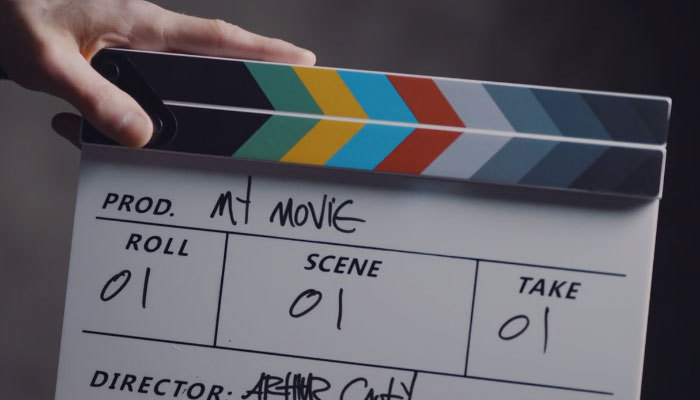Today, we’re talking with Terilyn Shropshire, ACE, about editing The Woman King. The last time I spoke with Terilyn, she had just edited The Old Guard. So, two films in a row with powerful female warriors! Terilyn has been nominated for a Primetime Emmy Award, and she won an ACE Eddie for Redemption: The Stan Tookie Williams Story.
Terilyn’s other credits include another action flick with a strong female action lead, Miss Bala, and the films Eve’s Bayou, Love and Basketball, and The Secret Life of Bees. Her TV credits include episode 1 of Ava DuVernay’s When They See Us. She was also an additional editor on A Wrinkle in Time.
Art of the Cut with Terilyn Shropshire on Editing The Woman King
Terilyn, it is so good to talk to you again. I have missed our chats.
Thank you for inviting me back.
What a spectacle and what a moving story. Congratulations on your contributions to the film.
Thank you.
To start off with — the opening fight sequence. If you have not seen this movie yet, the scope of this is epic. How do you wrap your brain around that amount of material? I would think that there's not a huge amount of specific description of these scenes in the script.
A lot of it starts obviously with the conversations that I have with Gina Prince-Bythewood, the director. We knew that in the first fight (much like any first time you're introducing characters), your audience has to be able to imprint on who these characters are going to be. For that first fight, our challenge, obviously, was that you needed to know that these women are formidable.
This is the first time you're going to see Viola Davis — as Nanisca — literally rising out of the grass. And Lashana (Lashana Lynch), who plays Izogie, and Sheila Atim as Amenza. This is the Agojie (the all-female army of the Kingdom of Dahomey). We wanted to show that these women were going to embody their characters both emotionally and physically. We wanted you to see them doing their own stunts. For the first fight, it was going to have to show how badass these women were.
We wanted to give a sense of who these characters were as individuals. Even if you did not know who they were yet, you were going to discover who they were. So that was the challenge. Also, you didn't really know: Why are they fighting? Why are they taking down this village? Obviously, that’s suggested in the opening prologue, but often an audience is still getting settled into their seats, so how much they take from the opening prologue, you really never know.
It was building the fight so that you had this formidable sense of what was going on. And yet we also gave you a sense of discovery. We weren't going to take you by the hand at the beginning and tell you exactly what was going on, but by the end, you would know why these women were fighting and what they were fighting for.
Gina decided that this would be the first scene that she shot.
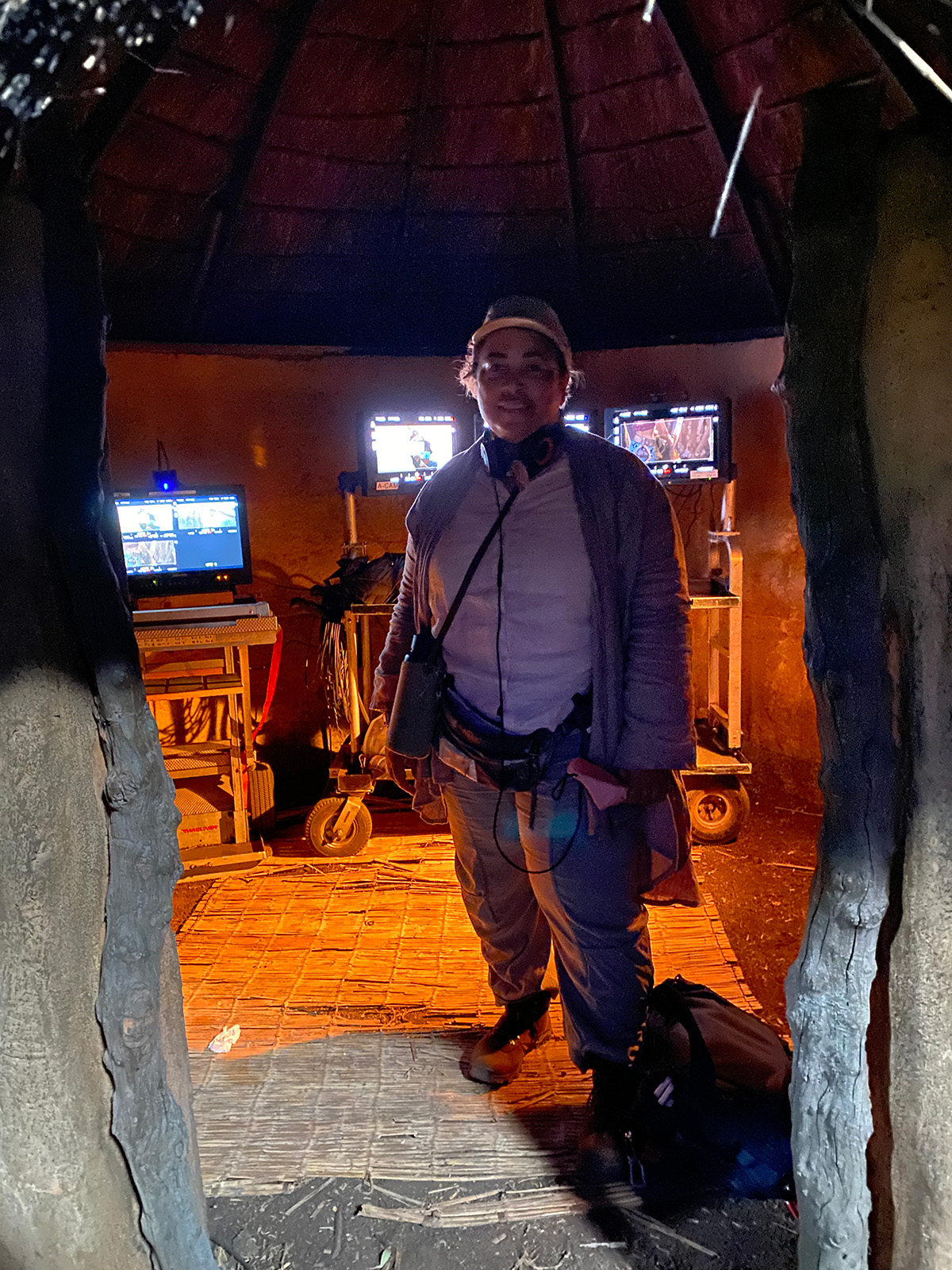 Terilyn Shropshire, ACE, editing The Woman King on location in South Africa
Terilyn Shropshire, ACE, editing The Woman King on location in South Africa
Wow!
I have to give her credit because on every film that she does, she chooses very deliberately — as I'm sure all directors do — what they're going to shoot first. She probably thought, “Let's get the actors into it. They've been training for this particular fight. Let's start out with this fight.” So, I didn't even have any time to ease myself in. It was pretty incredible from the beginning.
So it all starts with a conversation with your director. Can you give some specifics? Was it about the intent of the scene? What did she feel like she had to convey to you?
It starts by looking at the storyboards. How are we first revealing these women? From the rise out of the grass, what is that going to look like? As they run out of the grass, those angles are going to show that sense of speed and power and how these women fought together. How they physically moved through a fight. Who came out first, and how do they work together? It also involved looking at the stunt vis. I'm really fortunate to have worked with Gina for 20-some years now.
Those conversations that she even has with Danny Hernandez, our stunt coordinator. Because Danny did The Old Guard, we already knew each other, and Danny had come into the cutting room during The Old Guard. So we had this little family built already.
A lot of it was just getting a sense of what her expectations were going to be. Each one of these women had to show the absolute best of who they were and what they did. Anytime we go into a movie, the first images that you're giving the audience are so important. We talked about that a lot.
What were you doing as you were getting dailies? What do you do to wrap your brain around that huge fight as an editor? Do you do select reels?
There's so much footage! And every scene is different. Specifically, with the fight scenes, I had to approach each one differently based on how they were being shot and when they were being shot. When was the first unit going through? When was the second unit coming through? Was the second unit immediately coming through after the first unit? Because a lot of that would determine how I was able to move through dailies.
For instance, if we take the first fight, the first unit was capturing most of the fight. I knew the second unit would come back through, but usually, what I start to do is watch the dailies. I don't ideally like to either take notes or start pulling things the first time. The first time I just kind of wanted to be the audience.
With the amount of footage that was coming in, I kind of cheated a little bit where I would start to watch the dailies, but then I would start to pull movements because I always think of fight scenes as this aggressive dance of sorts. You want to be able to take each movement of a particular character and whatever they're supposed to be doing and make sure you have the best of the movement. So often what Gina and Danny would do on set is they would, you know, for instance — if it's Amenza and we're seeing her first movement with the spear where she attacks a person, they will have them do it from here to here, and do it again and again. So often — within a take — I might have 5, 6, or 8 versions of that same movement. I usually build selects of that. Or I would have my assistant build me a back-to-back of that particular movement. I would start with a particular character, a particular movement, and I find the best of that movement. So a lot of it was just doing a little bit instead of doing that overall thing, which I usually like to do, and then go in surgical. Sometimes I would start a little bit more surgical and then build the broader fight.
Then once I had those pieces, it was almost like creating these individual vignettes. And once I had those pieces, then I could put them back to back and start to intercut and move things around. In some cases, like during the first fight, there was a lot of choreography where they had one shot of all of them working together. We would move between one and the other. But as we saw the full shot, it almost felt like it was too intentional. So then we started to break up or do seamless edits between two takes.
Of all the fights, that first battle scene was the first one Gina, and I took the longest on to really put together because we knew it was the most important one with respect to our audience imprinting with our characters when we got to the Oyo battle.
There's an intention to each conflict in the film, and it's really important to make sure that you're honoring the intention while you're cutting.
The one that obviously took the longest to finish was the Oyo battle. The Oyo battle is about eight minutes of fighting. But what I love about the Oyo battle and how I approached it editorially was that — by now — the audience knows each character, so I could take each one of those characters and give them their movement within the Oyo battle. That's how I built that one: focusing on each character and who they were and how we could show that physically within the fight. How could we show Fumbe, who says, “I'm not a soldier.” Yet, by the end, when you get to the Oyo battle, she has become a soldier.
At one point, the production went on a hiatus while we were in Capetown, South Africa, because COVID was starting to tick up during that time. They kept me editing, which I was really grateful for because I needed the time with the amount of footage that was coming in from the first unit, second unit, and splinter unit. There was a certain point pre-Oyo battle where I thought, “OK, I'm getting caught up.” I'm feeling good. I'm feeling confident. And they come back up after the holidays with the Oyo battle. Visualize this mountain of data coming at me.
With these schedules, they want to give you a week to get the first cut out, which is crazy. I mean, there's no way I can get the first cut out of this movie out in a week, so then it starts to cut into Gina's director's cut time. Because we have a relationship, she's been very good about it. But, note to post executives: We need a little bit more time after a wrap like that. Oh, man. At a certain point, I start to feel like Gina's out there waiting to come in.
She would check in every day like, “How's it going? What are you working on?” And I would say, “Oyo battle.” Then, a couple of days later: “So how's it going? What are you working on?” I’d say, “Oyo battle.” It just became this joke: “Don't even call. You know what I'm working on. I'm working on Oyo battle. When it changes to something else, I'll let you know. I'll send you a text. I'll send up a flag when I'm out of Oyo battle.”
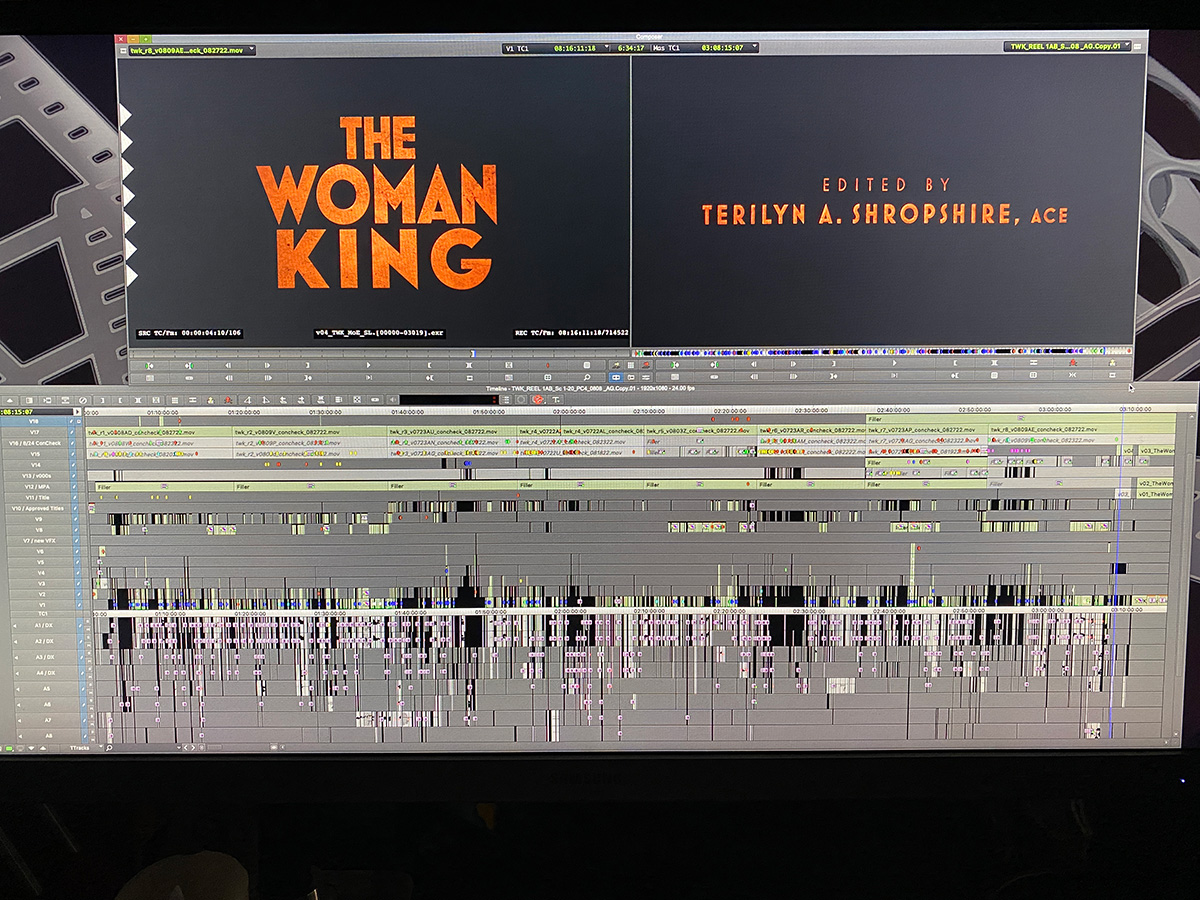 The Woman King, final locked timeline
The Woman King, final locked timeline
I wanted to clarify something that I love that you said. You said you were trying to figure out their “movement” in the film. You're not talking about their “action.” You're talking about a movement, like a movement of a symphony, right?
You are going through different movements of a symphony — an aggressive symphony, mind you. So for us, it was also about determining how to build the Oyo battle to its climax.
In some ways, the fights are written a certain way, but then you think, “Maybe that section should be over there?” Or “Do we need to pull that up? Where do we wanna put that?” Where do we wanna put that in the arc of a fight? When do you begin to start to see the fight change? This was very much a David-and-Goliath type of fight that had to be built. You’re finding those moments that propel the film and maybe surprise the audience in a way that is fresh and different.
You don't want to cut a predictable fight. You want to feel the turns of a fight. You want to feel the success. You want to feel those fallen warriors. The Oyo battle was non-linear being able to kind of move things around and see how it plays. It was the one fight that you had a certain ability to do that with. We knew the script had a certain intention, but there was also the freedom to kind of try some things in terms of moving certain parts of the fight around a little bit.
I’ve talked before with Elisabet Ronaldsdottir (John Wick) about the importance of showing the story of a fight. You need to understand the story elements of the fight even though there's no dialogue.
Dana Stevens wrote an incredible script, and Gina, as writer/director, worked with Dana a great deal on adding even more elements to the script.
One of Gina's favorite movies is Braveheart. One of my favorite movies is The Last of the Mohicans.
One of the best compliments I get about this movie from people is that they can follow the action scenes and they can see what's happening. It's not happening so fast that you can't tell what's going on. There's a certain point where we learn that Nanisca has a history with one of the main characters in the film. Ever since that incident, Nanisca has probably been thinking about what she’d do if she ever saw that person again. So then we have a fight where she finally has this person right in front of her. The fight that ensues is not the typical fight that this warrior would put on because she is fighting her past. She's fighting her demons. She's fighting the trauma. She's not even fighting smart. It was really important to show that part of it. That fight has so much more depth to it.
Talking with Terence Blanchard, the composer, about that, there was really a conversation around what the score would be on this particular fight scene because we weren't looking for a typical fight score. Terence really did a beautiful job of scoring this particular fight to convey what the emotional gravitas of this fight was. So this wasn't really a physical fight in the typical sense. It was more of an emotional fight over what she was going through within her head. It was an internal battle that obviously manifested itself within the fight itself.
Becky Sullivan was our amazing sound supervisor. We would have these conversations because we needed the sound of the fight, but what could we do to internalize it? Maybe let the weapons themselves be less and try to hit more of the vocal sounds of the two people who were fighting.
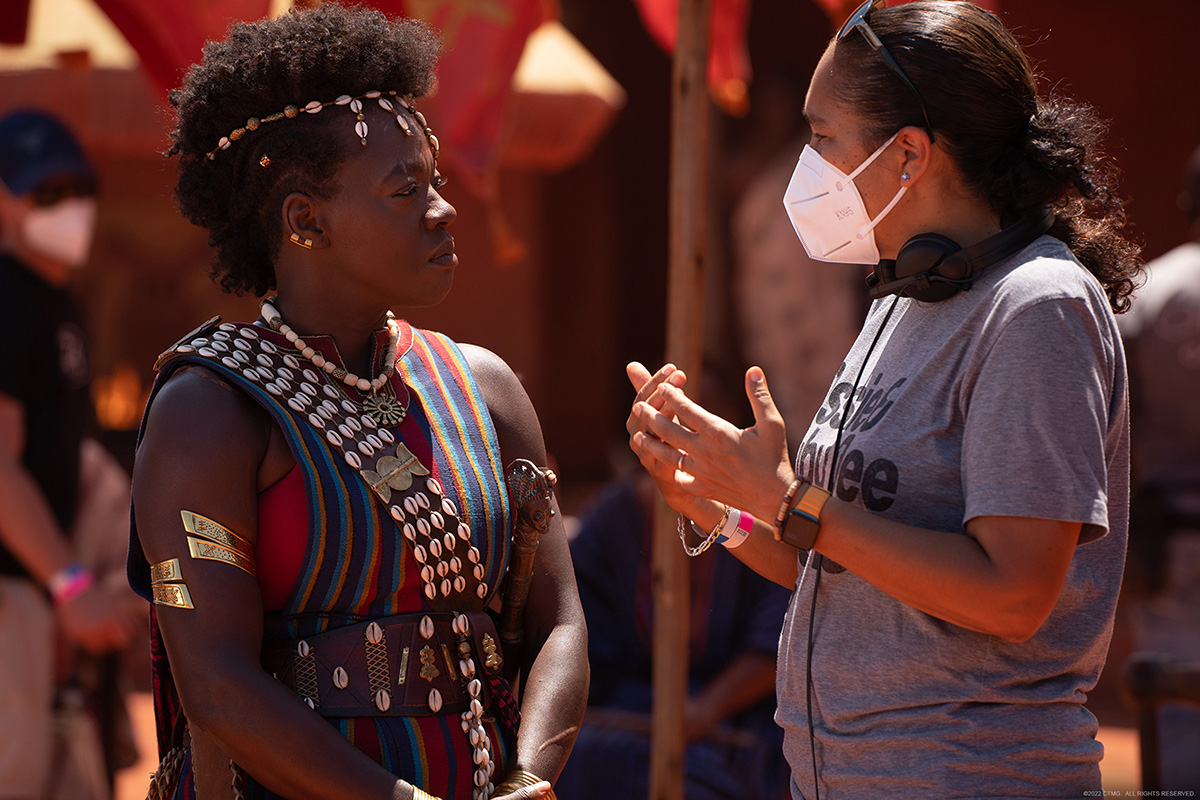 Actor Viola Davis (Nanisca) and director Gina Prince-Bythewood on location
Actor Viola Davis (Nanisca) and director Gina Prince-Bythewood on location
The “efforts.”
You and I have talked about the story of action and about “Why are we in the scene? What is coming out of this?” It is something that we talk about a lot, and certainly, it's something that's really important for this director to know that her action scenes are as purposeful as the dramatic scenes.
In addition to the big epic stuff, there's just such wonderful care taken with the nuance and the subtleties of the actors. Of course, you've got Viola, who's so expressive. Can you talk about what you're looking for as you're watching dailies and the things that catch your eye when you're looking at performances in some of the more intimate scenes?
We had such beautiful dialogue between these women, but this film was a gift with respect to the women, the actors that came to this film: Viola, Lashana, John... A lot of what they were feeling or experiencing was, in some ways, in the silences, especially with Nanisca. Nanisca is a warrior, a seasoned warrior who has learned in some ways not to show her vulnerability. She's someone who's trained every single one of these other warriors. She wouldn't typically reveal any kind of vulnerability or pain, but in this film, she kind of peels away that layer, and we take that journey with her as she does. It was truly incredible to be able to edit Viola because she says so much with so little. You don't really have to work that hard to find that. Part of my job is to give you little fissures of her vulnerability until it completely opens up.
Even in those moments where we're starting to see her interact with Nawi, her recruit, obviously, she has a certain degree of intensity. I like the moments that hang on her a little longer to allow the audience to see the other side of her that she's not allowing the other people to see.
She's the most open with Amenza, her wing gal, her second command. Those were scenes where I could allow both of them to be more like sisters. More relaxed and share who they were a little bit more.
What's interesting about this film is that each one of these characters reveals themselves in a very different way. In many ways, they each have their own chakra. There's that vulnerability of being a woman at the top of your game and yet seeing those moments where you do see her as a warrior who's been through a lot. The great thing about working on this movie is that we could have the intensities of the fight, but we could also show the humanity of these women and these warriors, and that's absolutely deliberate. Often the pace would slow down a bit in those moments. Sometimes there's an expectation that the entire thing will be like how we start the film and — depending on how you interpret the film — is an action film. For Gina, it was always supposed to be a historical epic with great action. I got to use all those tools, all those muscles in this film, which was pretty special.
I noticed a shot with just the slightest twitch of a lip or an eye, and I just loved the subtlety of what that little micro-expression gives me. It's so obvious the care that you took in finding and keeping that moment in the film that gives us a look into this character's soul.
One of my favorite scenes in the film is probably one of the slower scenes in the film, which is a scene with Amenza and Nanisca. There's a moment where they start to talk about the past, and it's intense, and yet it's quiet. It's a little bit of a slow burn because these two characters are unpacking something that both of them have suppressed for a very, very long time.
I'm sure as humans, we've all had those moments in our lives where something has happened, and we have to kind of take a moment and unpack it a bit. That's where I think you have to be really careful because you don't want to edge into what would be considered negative melodrama. There are places where the audience is going to be ahead of you, but the question is, if the audience is ahead of you, are the characters ahead of you? In other words, sometimes, I think as an audience member, you should allow yourself to be ahead of the character but then allow the character to go through what it needs to as you're watching.
I hope that this is a film that people will go to for the first time and just experience it. Then go back again and maybe pick up things they didn't pick up the first time. That's what I love about movies. When we go back, we find things that we didn't see the first time.
I really did love the characters. I wanted to spend more time with those people.
It's always great to ask people who your favorite character was because there are certain people that are totally Team Izogie, and then there are people that are Nawi or Amenza or Nanisca. A lot of people can see themselves in each one of these characters.
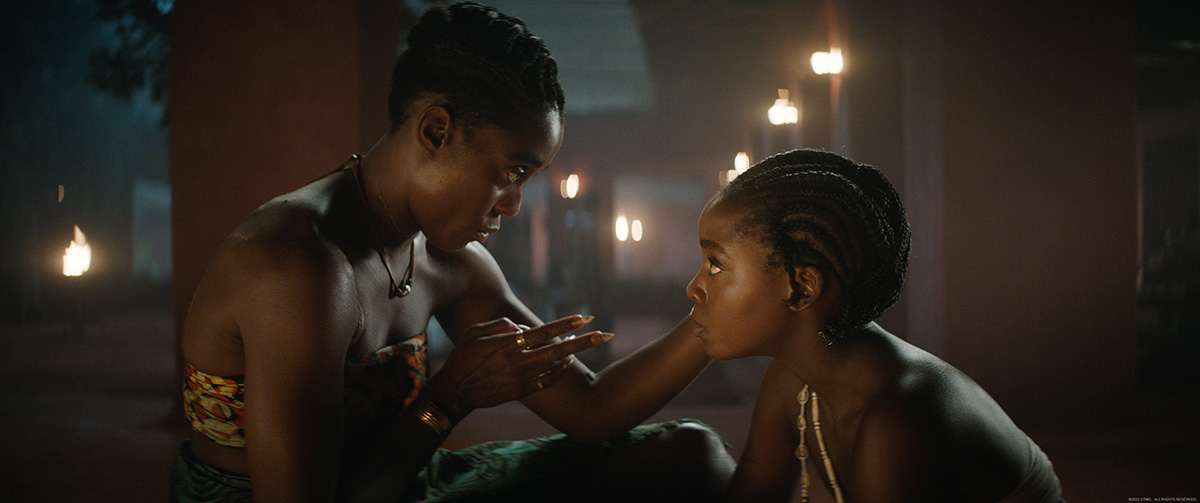 Actors Sheila Atim (Amenza) and Lashana Lynch (Nanisca)
Actors Sheila Atim (Amenza) and Lashana Lynch (Nanisca)
I’m definitely Team Izogie.
Most people are. I think because she has this fierceness. She's funny, and then there's obviously a beautiful human side to her.
You mentioned the composer a little bit. How much do you use temp score to communicate — if at all — to the composer? How much of it is purely to help you and the director and anybody else that's watching the thing feel like it's a movie?
The score played an incredibly integral part from the beginning. Gina knew at the very beginning that she wanted to use Terence for this film. At the same time, this was one of the hardest films — bar none — for me to temp. We've never seen anything like this before, so when we started to kind of try to pull music prior to Terence coming on and giving us demos or suites or that type of thing, it was really challenging. In the beginning, I worked alone on that, but we had two music editors. We worked with Louie Schultz, who works with Terence and Del Spiva. We've used Del a lot. So, I did a little bit of research myself. I'll start listening to things. We knew that Gina wanted this movie to be score-driven. It wasn't like her typical film where we're kind of integrating both score and source-type music. It was challenging because I couldn't find the voice. It was just going through scores that I thought would maybe give some kind of similar type of feel. Gina wanted it to be a combination of classical but very African-instrumental driven. I also really feel that it's important to be careful — when you know who your composer is — using music from their other scores because I think that those particular scores on any film are set for a particular mood or particular intention within that movie. Even in listening to Terence's past scores, which are sublime, they weren't the score that I knew that he would want to represent for this one.
Diane Reeves, whose voice you hear, is our vocal layer throughout the film. She came on and just did such a beautiful job with Terence's score. There's a certain point in the film where you hear Sheila Atim (who plays Amenza), and you hear Lashana Lynch (who plays Izogie). and you hear Adrienne Warren (who plays Ode) do this call-to-arms. It was based on something that Angélique Kidjo had talked to the actresses about because Angelique is actually in the movie.
The score part of it certainly was absolutely my most challenging thing during the early process until Terence delivered what he delivered. This is my sixth project with Terence, and this one just blows me away every time I hear it.
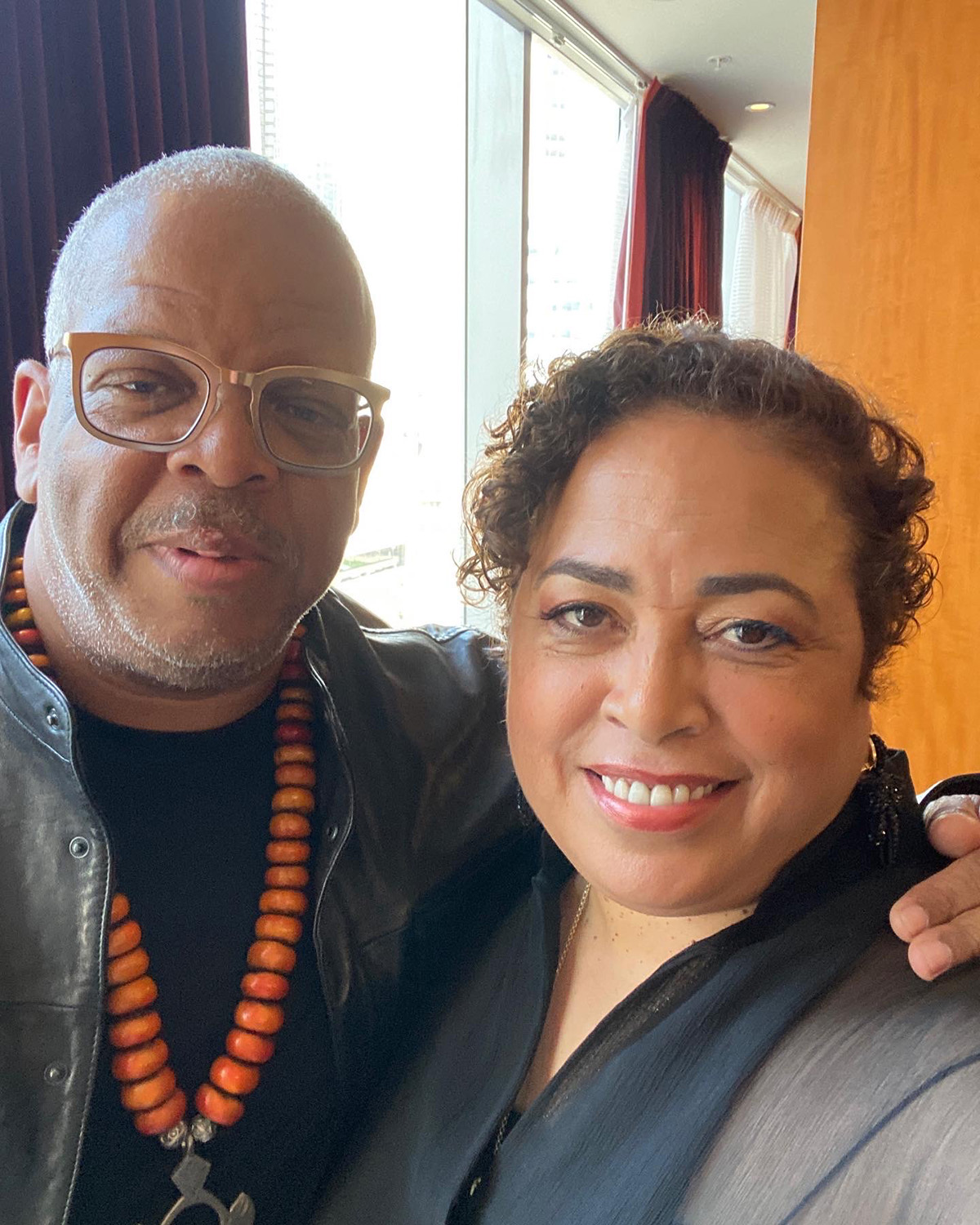 Composer Terence Blanchard and editor Terilyn Shropshire at TIFF World Premiere
Composer Terence Blanchard and editor Terilyn Shropshire at TIFF World Premiere
Can you talk to me about the training vignettes? Were they shot as vignettes, or were they culled from longer scenes?
They were shot as their own scenes. In fact, the scene where you see Izogie flip Nawi was a much longer scene. It was definitely much longer. She flips her a couple of times. Then she kind of then teaches her how to correct it.
The running scene when Nawi is running and then she gets winded, that scene was much longer. The training scenes were much longer. We know how many times audiences have seen training scenes in films, so how do you take a training scene in 1823 with these recruits and make it a little bit different? And yet it's still going to be a montage about these young people training, failing, and learning. Except for this time, it’s with machetes and muskets and physical contact.
I think what was really helpful was putting some humor into it. Allowing the audience to see that Nawi was somebody different yet still trying to find her way. What I love about our training sequences is that maybe you didn't necessarily recognize the oil, and yet you are able to learn through the training scene. They oiled themselves so that it was harder for their opponents to grab them. It's not really explained...
But I got it. I understood the point of it without it being spelled out.
Then the same thing with the rope. She says, “A rope is not a weapon.” And then she ends up using the rope to ultimately prevail. This film is planting the seeds that you can kind of pay off later. We work to find a way to build them and set them in a montage where it keeps the story moving and hopefully is still fresh.
Let’s talk about building tension. There's a scene where the king has to pay tribute, which is basically like a tax or a bribe essentially for doing business. That was very tense to me. Talk to me about building that tension and then the release of the tension and how you do that editorially.
That's where I really find myself as the editor. With respect to the tribute, it starts as a celebration, but within the tribute, what really starts to break it apart is the sound of the horses. You start to hear the horses and what you learn about the Oyo is that they were a tribe that had more horses and more muskets. They had more of a Western type of approach to their warfare because of their connection with the European slavers. So it was really crucial that when you hear horses in the film, it was always going to connect you with the enemy with the Oyo.
The idea is that they come in formidable. And when you hear Terence's score, there is a rhythm between what's happening over the Oyo and showing that intensity of King Ghezo meeting his foe. I pulled my love of westerns into that scene.
I thought it was like a classic gunfighter duel facing down at noon.
Yep. Exactly. It was holding those looks. Then there's something else that's happening that gets discovered within that scene, which even adds even more to it. So we're struggling with these two tribes who are on the brink of war and diplomacy, which in some ways is so connected to our present day. There’s a lot going on there. It was really important to give each layer its own moment. I think that's what really helped create the tension, but also, I felt like sonically, Becky and her team did a beautiful job of playing the environmental things, even within the silences of that moment when they're standing off and the reaction of the whole kingdom. It's the first scene where the audience really locks into what the stakes are and what this particular kingdom is up against.
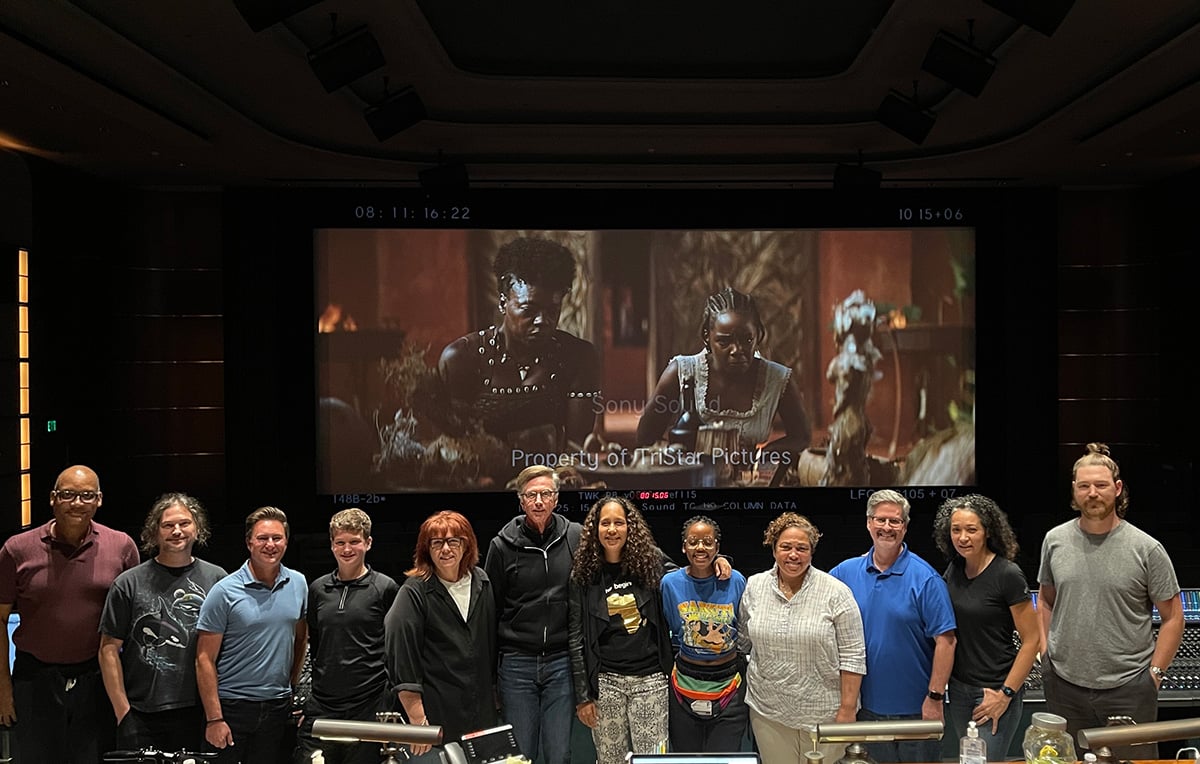 The Woman King, final mix with sound and music team
The Woman King, final mix with sound and music team
One of the things I love talking about is intercutting — the value of it and whether it follows the script or not. You had some intercutting in a scene where the warriors are dancing while, at the same time, they're preparing for war. Can you talk about intercutting those two scenes and what kind of juxtapositions you’re trying to create? What's the value of intercutting instead of having them separate?
The thing about the Agojie was that part of their preparation for war was to dance. It’s an aggressive kind of war cry. The scenes were shot separately. The battle dance with the Agojie female warriors was its own sequence. In fact, when we first put it together, it was built as its own sequence. As you start to build the film, you want to start to build towards a certain intensity. How can we start to connect all of those things for the audience?
The first thing that we did was to begin to intercut the battle dance with the physical preparation for war. Part of what came out of that was never wanting the battle dance to feel like a performance: stepping out with a wider camera and showing the physical dance itself from different angles. But at a certain point, the Steadicam guys were literally moving around as the women were doing the dance, but Gina and I also really never wanted it to feel like, “Okay, we're stopping the movie to show the Agojie doing a performance of the battle dance.”
When we started to really look at creating a more non-linear connection and helping the audience understand what was going on, it made more sense to intercut. We had intercut to a certain point, but where we stopped intercutting was Viola’s speech. We were being a bit protective over that speech because you'd go into the battle dance, and then we would end with her speech. We wanted to be really careful about not diluting the speech or the intensity of the speech, so we kept it at the end. We didn't even have Oba Ade in there. In fact, in that scene of Oba Ade — giving away a little movie magic here — the actual placement of where Oba Ade was with his men was in a completely different place. We were trying to figure out, “How are we gonna get Oba Ade?” Because it was important also to see the enemy, to see what they were talking about. It's so hard to call it a battle dance, but it is this choreography of aggression.
Our producer, Cathy Schulman had come into the editing room and asked, “What about Nanisca’s speech?” We told her we tried it, but we wanted it to have its own moment. And she said, “I'd like to see what it looks like. Why don't you guys just try it?” So Gina tasked me, “Go do your thing.” My timeline is quite stacked. I'm a stacker. I like to build my timeline in such a way that V1 has most of the movie, and then on 2, 3, 4, and 5, I may have multiple takes of something.
The battle dance looked like an accordion of sorts. I was now building Nanisca’s speech. I was trying to decide, “Where am I going to come into and out of Nanisca?” I almost wanted to create a call-and-response. So when she was saying what she was saying, how the women were responding with their physicality within the dance. I showed it to Gina, and she said, “I miss this part of the dance.” The complete dance was pretty amazing. It was trying to incrementally slide things a little bit to the left, a little bit to the right to get to the point where she said, “Okay, we're good.” The next thing was we had to show it to Viola. Viola's a producer on the movie. We didn't want to do anything that would've diluted or diminished that character.
What was great about Viola is that she was not precious. She was someone who could watch the film and not covet anything. She's amazing. We showed it to her and the other producer, Julius, her husband, and they just loved it.
The Woman King, prepare for battle intercutting scene
I love this idea of your receptivity to a new idea as an editor. And even if it doesn't work out, what it would teach you about what you're left with.
It's always a challenge. It's a tricky conversation because, at a certain point, I've always said you can't covet. You can take pride in what you do. You can't covet it. We work in commercial art. We work in collaborative art. We have people paying to make these films, and yet you still have to be the filter through which the best of the film moves through. And that doesn't necessarily mean that you're always gonna be in agreement with anybody who's giving you notes, including the people who have the purse strings and who have the power to want you to do something. That's the strength of Gina as a writer/director. She knows her film and knows her characters. Whether they realize it or not, she is listening to everything that they're saying, and she's taking in the note. We may go in and try the note or try something similar because sometimes the note is not the note, but it's telling you there's an issue there. I think many editors will say the same thing. Often, they want to give you the note, but then they wanna tell you how to fix it, and that's really where I think it's complicated. We want to hear the note. We want to hear what your issue is, and then we want you to leave us alone and trust us as artists to give you the solution or to evaluate if it really is a problem. That's where sometimes you have to hope that they will trust the filmmaker to know that. They're gonna do what's best for the film and the characters.
At the end of the day, when everybody goes away, it's still gonna say directed by Gina Prince-Bythewood. She's gotta be able to stand by every single decision she makes. Every single one.
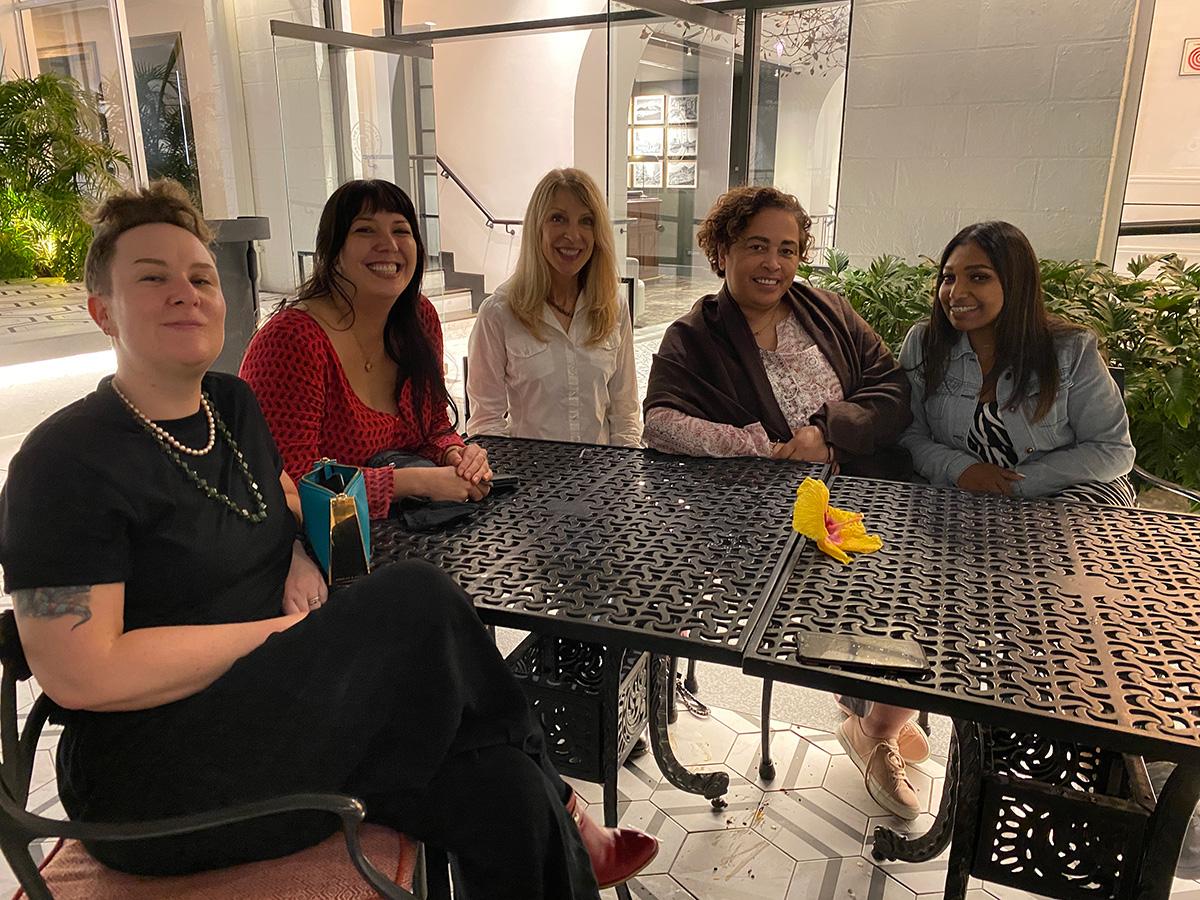 The Woman King, post team South Africa (L-R): Jess Phillips, Asst Editor; Aldine Bronkhorst, Asst Editor; Corinne Villa, 1st Asst Editor; Terilyn Shropshire, Editor; Sashnie Moodley, Post P.A.
The Woman King, post team South Africa (L-R): Jess Phillips, Asst Editor; Aldine Bronkhorst, Asst Editor; Corinne Villa, 1st Asst Editor; Terilyn Shropshire, Editor; Sashnie Moodley, Post P.A.
I saw the film in IMAX. Did you have to consider anything about the IMAX format in your editing?
It’s interesting that you ask that because one of the last official duties I had as editor was to go to the IMAX at Playa. I hadn't been in that building before. It was one of the last times I saw the film before it went off into the world and also DolbyVision. I would say that there's nothing that we did in preparation for IMAX. In fact, the first time I saw the film in IMAX, it blew my mind. I've never seen my film that close. It was daunting and exciting.
Now, if you're asking me, would I do anything differently now that I saw it in IMAX? I don't think so, but it was a bit shocking. The detail is just crazy. I think that Polly (Morgan), the cinematographer, and Gina had watched it before I did, so I think if they had anything to say about it, they would've made adjustments.
Once the climax of the film happens, there's still a bit of story to tell. The audience is really looking for an emotional payoff, but how do you know how quickly you can get to the end without losing that emotional connection?
That's a great question. Because within this movie, there is an expectation that we are done at the crowning, right? I think you can give it away.
It's in the title!
You could argue that the movie ends there, and yet everything that Gina has done to take you through a journey with these characters would suggest to you that there's still some unfinished emotional business, right? So as an editor, how do you allow yourself to say, “wait, wait, wait,” yet not have the audience have a sense of multiple endings? Certainly, that could be argued. Yet if you don't look at this movie as a typical movie with a typical Hollywood ending, you might realize that no, there aren't really multiple endings.
Again, it came down to a discussion of transition and how to make these transitions feel like we don't have a beginning, middle, and end but that the ending of one scene takes us into the next scene. You don't go to such a high level, both sonically and musically, during this period. We specifically talked to Terence about, “We are going to need your help to help us make this transition in such a way that we are not teasing the audience in such a way that they think, ‘Okay, this is absolutely the end.’”
So when you go from the crowning into the scene that follows, if you go back and listen to what Terence does with the score, he takes us over that transition in such a way that it really helps us to be able to keep going into the end. And, and I felt ultimately visually it was something where you don't see us ending the crowning in some big wide shot. That kind of typical shot size that you might end a film.
That was really part of it. Ultimately it had to do with being in a place where if you've invested yourself into the characters when you really get to the point where we're at the end, you really understand that this movie is going to end with a certain degree of joy, but also reality. It's not just about ending with certain characters dancing or in celebration because the truth of the matter is what they were fighting against was something that was not solved in the space of this film. This was a more complicated story than just happy, happy, joy, joy. These women would have to continue to be warriors to continue to fight against something that would last a lot longer.
You've mentioned several times the historicity of this story. Did you do any research?
I've been really fortunate to be a part of stories where I've learned parts of history. I'm always in this place of: “How much do I want to know?” or “How much do I want to allow myself — like the audience — to learn during the journey?” I think many of us really weren't aware of this until we saw Black Panther. Gina often says that this film could not have been made if it wasn't for Black Panther and the success of that movie. She's always giving props.
But to answer your question. Yes, I did a bit. I didn't go deep. Gina had certain books that dealt more with them specifically. I did a little bit of looking, but I didn't go deep into it. I went as deep into it as I needed to tell the story.
This is another place where I get a variety of opinions. Some editors tell me, “I never do any research because I want to be in the same place as the audience.” And other people say, “I need to be completely immersed. I need to know everything I can possibly know.” So everybody's different.
My immersive experience is within the characters that these actors are playing and their performances. Obviously, there were things that I wanted to make sure that we got right, and I would often talk to Gina. “Is this something that they really did?” “Was this something that was true to their character?” I often used Gina as my professor. She wasn't going to put anything in the film that she felt was not accurate or inspired by the real characters. So there was like even the Bramble scene...
I can't think about that scene again...
The truth of that scene is that the Agojie actually had to go through it three times!
Can you tell me a little about your assistant editor, Corinne Villa? Can you talk to me about finding her? Interviewing her? Why did you choose her, and what makes her a great AE?
Corinne was on The Old Guard. That was our first film together. I knew after that one I was going to get her back for this one. The reason Corinne is so great at what she does is that she's kind of old-school like me. She came up through film cutting rooms working with directors like Bob Leighton. I was really lucky to get her. She has this incredible knowledge of visual effects. She's worked both as an assistant visual effects as well as an assistant editor. So even early, and even though we had an amazing visual effects team (Rebecca Weingold was our visual effects editor), having Corinne in the editing room who could communicate on the same level of language with the visual effects team as my first assistant is incredible. Corinne is someone who is a proactive person. She's always thinking weeks and months ahead. She's just very intuitive about that.
What's also great about Corinne is that she's the first person who starts to see not only the dailies but also the cut itself. Even with dailies, I'm asking her to pull selects, or I'll have her start to put together something for me. A good example was that there used to be a lot more Palm oil harvesting scenes. So I’d go to Corinne and ask her to start building that sequence. And I know that she will build an incredible foundation from which we can work. She's just really good at communicating with every single department, whether it's the script supervisor on set, the camera, the DIT... She allows me to be able to go into my room and just be creative. I don't have to deal. I mean, there's so much within a cutting room that people just have no idea that has to be managed when you're in production. Communicating with the second unit team, the first unit team... she helps filter that. I just completely trust her. I could not wish for a better partner in this. And even the director, Gina, relies a lot on Corinne in terms of getting information to and from the studio.
She's just grace and calm under pressure. I hate drama. I say: “The only drama in the cutting room should be on the screen.” Most editors feel the same way.
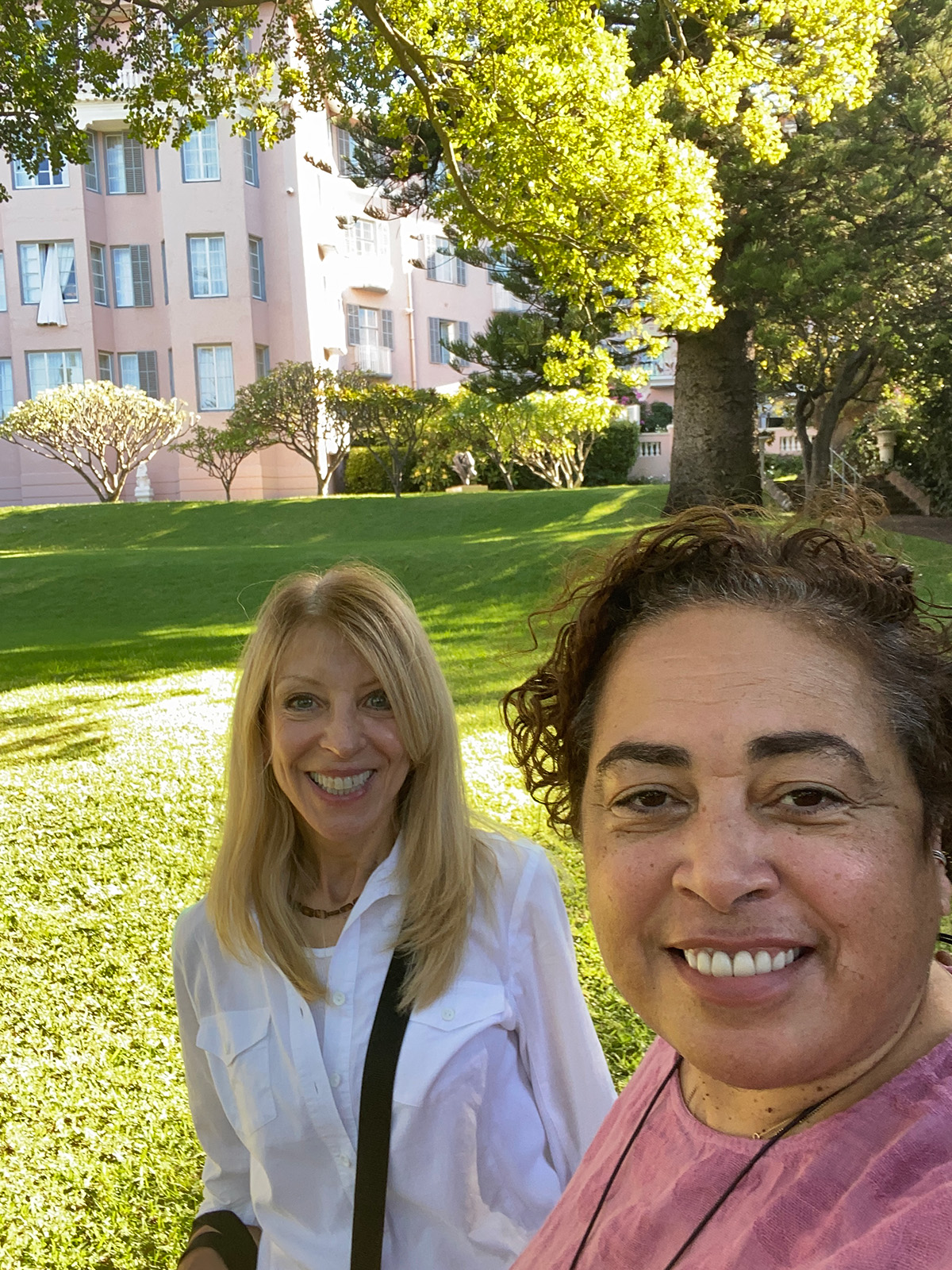 Assistant editor Corinne Villa and editor Terilyn Shropshire on location in Capetown
Assistant editor Corinne Villa and editor Terilyn Shropshire on location in Capetown
I'm putting that on a t-shirt.
She keeps that room running. She keeps the drama out and allows me to be my best self because I don't have to deal with a lot of things. I can focus on the film and the story. And then, my assistants are the first to see things. We bring 'em in. We sit 'em down. We say very little. They’re the first sounding board.
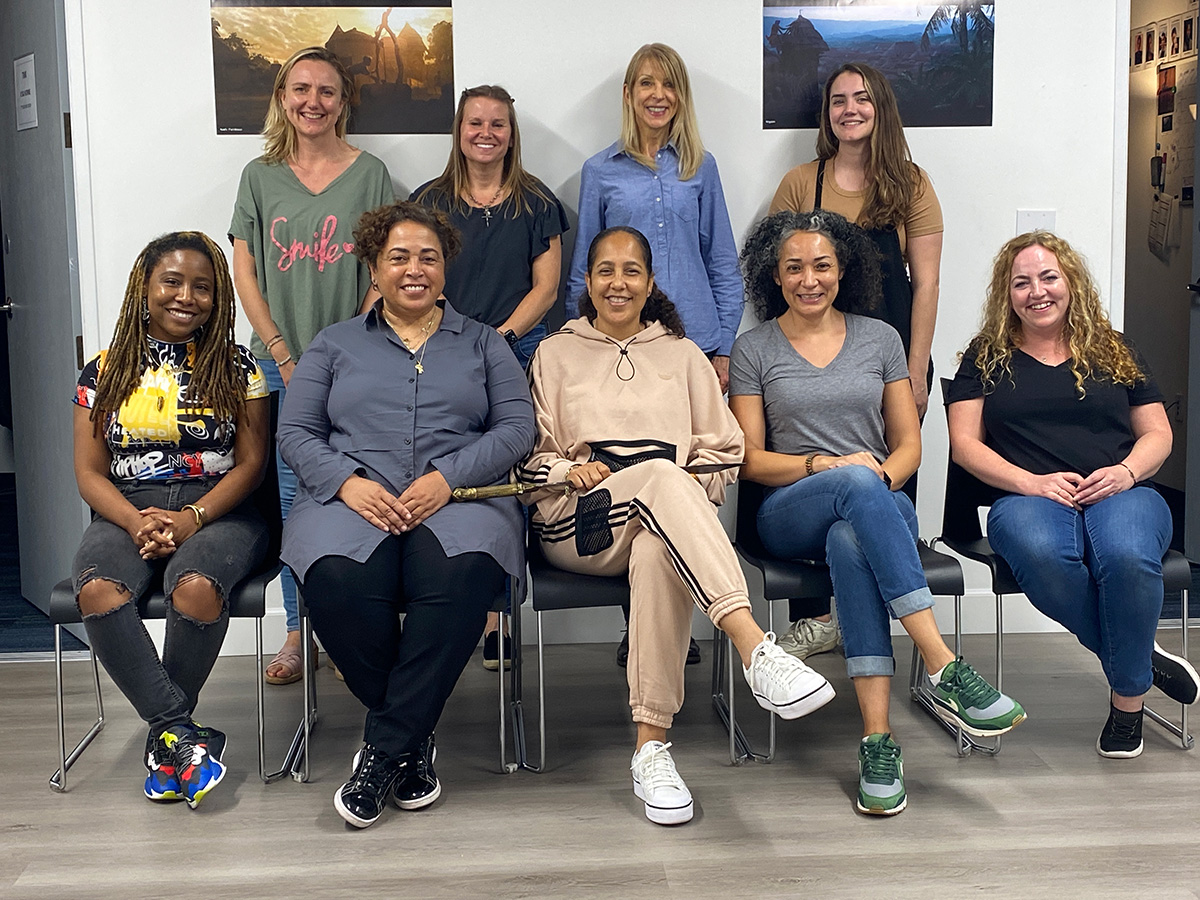 The Woman King, post team Los Angeles, front row: A'sia Horne, Asst Editor; Terilyn Shropshire, Editor; Gina Prince-Bythewood, Director; Sandra Perez Thomas, Asst to Director; Sara Bennett, VFX Supervisor. Back row standing: Claudia Dehmel-Vfx Producer, Rebecca Weingold,VFX Editor; Corinne Villa, 1st Asst Editor; Sarah Rosenthal, VFX Coordinator. (Not pictured: Obinna Onyeri, Post Production PA., Ana-Maria Garcia,VFX Production Mgr)
The Woman King, post team Los Angeles, front row: A'sia Horne, Asst Editor; Terilyn Shropshire, Editor; Gina Prince-Bythewood, Director; Sandra Perez Thomas, Asst to Director; Sara Bennett, VFX Supervisor. Back row standing: Claudia Dehmel-Vfx Producer, Rebecca Weingold,VFX Editor; Corinne Villa, 1st Asst Editor; Sarah Rosenthal, VFX Coordinator. (Not pictured: Obinna Onyeri, Post Production PA., Ana-Maria Garcia,VFX Production Mgr)
That was a lovely tribute. Terilyn, what a wealth of knowledge you shared. Thank you so much for your wisdom, your time, and generosity.
It is a pleasure anytime we can talk about what we do. I always think of it as a gift. It's wonderful to talk with someone who asks the right questions and has the intuition to see those elements of the film. So thank you.
I'm expecting to see you at the Oscars.
From your mouth to the universe... and the Academy’s ears.

